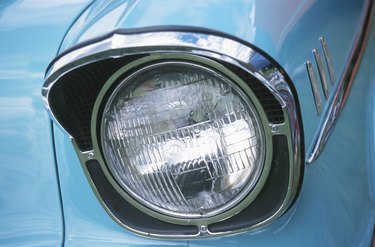
Deciding whether to go with clear enamel or lacquer does not have to be a tough choice. Start with the type of surface you are working on, such as wood or metal. From there, consider how it will be used. For example, if you are restoring a vintage automobile that sees more time inside of a garage than street traffic, you can go for the show-quality look of lacquer. If you need a durable finish for a wood coffee table -- a top coat of enamel will be the best way to go.
Clear Enamel
Video of the Day
Clear enamel is like lacquer, in that you can apply it on wood or metal. However, clear enamel is more durable than lacquer. Another distinction is that clear enamel is a topcoat. You can't mix it into paint as you can with lacquer. This is why many people refer to clear enamel as a varnish. However, that term is more correct for wood versus metal applications. Clear coats come in spray and paint-on applications. A "basic" lacquer application is typically painted on, except in the case of auto-painting where lacquers are sprayed on with professional-quality equipment.
Video of the Day
Lacquer
Lacquers are used by those who want a thick, high shine. Lacquer makes wood or metal objects look like they have a shell on top of the surface. When lacquer is used, the eye sees two layers – the top layer of the wood or metal object and the layer of lacquer on top of it. There are three primary types of lacquers: nitrocellulose, acrylic and catalyzed. Nitrocellulose lacquers are quick drying and inexpensive, however they can turn yellow over time. Nitrocellulose lacquers are good on wood, but not so good for metal surfaces such as vehicles. Acrylic lacquers avoid the yellowing problem. They go on crystal clear and stay that way for a long time. Catalyzed lacquers are hybrids that cure chemically versus through the evaporation of solvents. Furniture manufacturers and auto paint shops primarily use catalyzed lacquers. Acrylic lacquers are typically reserved for classic car restorations and by hobbyists and painting professionals who want "show quality" results.
Similarities
Both clear enamel and lacquers come in acrylic formulations, adding to the choices (and decisions) you have to make about which one to use. Acrylics can be petroleum-based or water-based. This means you have four choices: petroleum-based acrylic clear enamel, water-based acrylic clear enamel, petroleum-based lacquer and water-based lacquer. Water-based acrylics are also called "aqueous acrylics." It is important to prime the surface with the right type of primer. Choose a primer made specifically for enamel or for lacquer.
Differences
Clear enamels dry and cure on top of the painted surface. They contain solvent agents that evaporate once the surface is dry and cause a chemical reaction with the surface that makes the surface hard. Lacquers, on the other hand, dry but technically speaking, they do not cure. There is no chemical action between the lacquer and the surface of the object. That is why you see the top layer of the object separately from the layer of lacquer. Lacquers and enamels should never be mixed together. It's like trying to mix fire with water. The lacquer will "eat" the oil in enamel. However, you can use petroleum-based enamel on top a coat of lacquer.
- Craig Central: Paint Types; Robert Foster
- Fine Woodworking: All About Lacquers; William Duckworth
- Learn Auto Painting: Determining Your Auto Paint Type
- Low Rider Bike: Paint Report; Mike Tellez; March 2009
- Spazztic Crafts: Finishing: When to Varnish or Clearcoat
- Chuck Hawks: Harley Paintin’ for the Under-Funded and Under-Skilled; Dave Murray